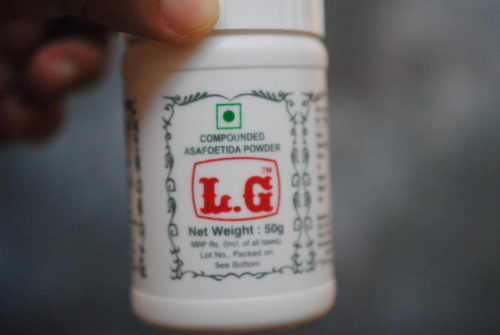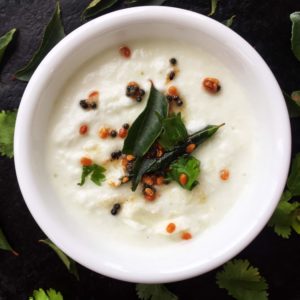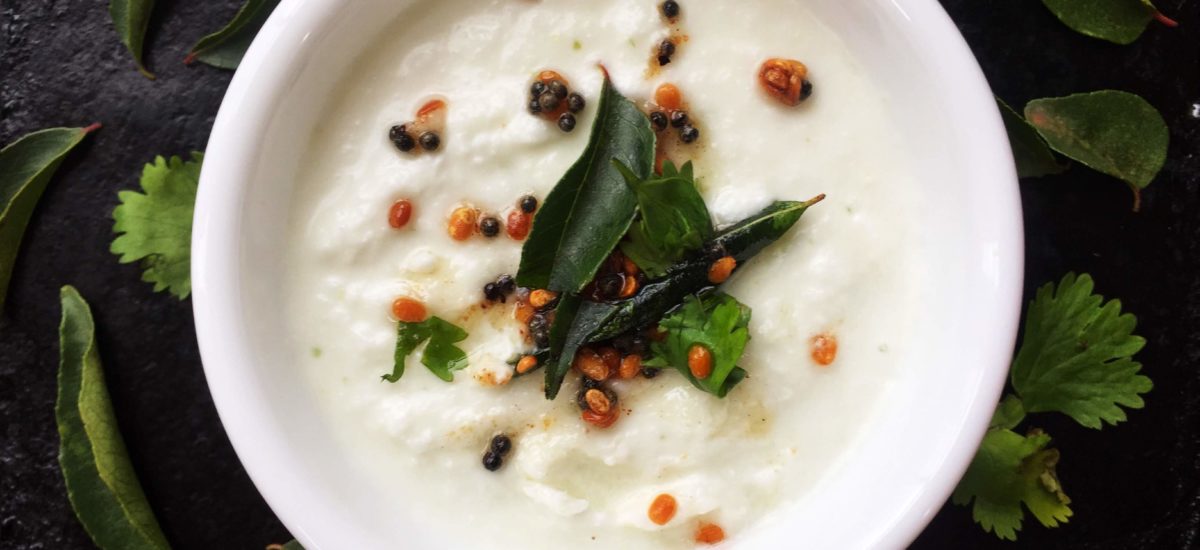Coconut Chutney is an integral part of Indian food.
The chutney varieties in India are extremely diverse, with ingredients ranging from mint, yogurt, mango to peanuts. In South India, coconut chutney is the most popular and simplest of them all. This is a minimalist’s paradise! It is effortless, quick, versatile, and made of very few items that are common in a South Indian household.
This recipe is for a classic coconut chutney that you might see accompany most South Indian dishes at home or at a restaurant. Typically, coconut chutney is featured as a side dish to many breakfast items such as idli (steamed rice cake), dosa (rice-lentil crepe) or rice dishes like pongal (click here for my pongal recipe!). This is one of the milder chutneys – it is soothing to the palate and is a spice-buster that helps bring down the heat of your main dishes.

You will need a blender or grinder.
I use this Cuisinart food processor, but a simple blender does the trick too.
Grind the coconut, green chili and ginger together. Then, temper the coconut mixture with mustard, urad dal, asafoetida, and curry leaves. Garnish with cilantro and you are done! You’re already an expert Cumin Being!
See my Rasam recipe for more information about dal and asafoetida, two common staples in the Indian Kitchen. Both ingredients are found at any Indian food store, and of course, on Amazon (what are you gonna do?).
While Rasam uses tur dal, our coconut chutney calls for urad dal. Urad dal is commonly known as matpe or mung bean lentils, and it is rich in vitamin B and protein. It’s basically a boon for vegans and vegetarians alike, and an easy way to get an extra serving of protein in your day!

Tempering the seasoning is crucial.
I write this in almost every recipe, but when we call for tempering, we mean it. Tempering spices is very commonly known as tadka in various parts of India. It is a beautiful way of amplifying key spices and herbs that ultimately sit at the very top of the dish when served. It brings out an incredible aroma, especially when tempered in ghee, which releases the essential oils of each spice.
History
The term “chutney” has gone through various identity crises. Originally, the word “chutney” is derived from Hindi “chatni” (चटनी), which means “to eat with appetite.” Great – we can totally relate. The first uses date back to 500 BC in India as a way of preserving food by pickling vegetables and fruit. Chutneys are served with almost every or any meal in India, either made fresh or cooked, and range in flavor from sweet, sour, spicy and mild. The unifying quality of chutneys across the subcontinent is that they originated from grinding ingredients together into a saucey paste. These days, it isn’t uncommon to use food processor or blender, but so we’re clear, the idea of chutney is to bring vegetables and spices together to compliment the meal.
Chutneys vary from region to region. Coconut chutney is classic in South India. In the South, chutney powders are even made from roasted dried lentils to be sprinkled on idli and dosa, which is then eaten with creamy, spicy chutney. On a traditional South Indian thaali, you won’t be surprised to find a few different types of chutney – coconut chutney, a green mint/cilantro chutney, and tomato chutney.
British presence in India solidified the term “chutney” to globally be regarded as a preserved curried jam of sorts. While this isn’t completely wrong, as chutneys were used for preserves, the overwhelmingly sweet quality of Western chutneys is a slight aberration from the spicy, tart varieties found throughout India. If you’re interested in the chutneys of the pros, at least in the South, I’d start with the coconut chutney. Nothing pairs better with a spicy masala dosa, or a spongey idli.
Spice Mix

We are always looking for ways to decolonize our spice rack.
If you are need of any of the spices for this recipe or others, we encourage you to shop at Diaspora Co. for all your Indian spice pantry needs! We do our shopping in local food stores and Whole Foods alike, but where our food comes from is meaningful to us. Diaspora Co prioritizes the support of local farmers, who are at the cutting edge of regenerative and sustainable agriculture. Consider supporting them and similar businesses!
Before I close, we should talk about the versatility of this chutney. For my traditionalists out there, this would be perfect with pongal, idli or dosa. For my adventure-junkies, the possibilities are plentiful:
- Chaat condiments
- Veggie and chip dip
- Cracker & Cheese Plate
- Rice or Buddha bowl sauce
- Bread spread
- Salad dressing
- Rice cakes
If you try our classic coconut chutney, let us know how it turns out, and how you’ve chosen to pair your chutney! Until then…
Stay Cumin.

Coconut Chutney
Ingredients
- Coconut – 1 cup
- Green Chili – 2
- Ginger – ⅛ tsp chopped
- Yogurt – 2 tablespoons
- Mustard – ¼ tsp
- Urad Dal – ¼ tsp
- Asafoetida – a pinch
- Curry leaves – 4 to 6
- Cilantro – 1 tsp chopped
- Water – as needed
- Salt – as needed
- Oil – 1 tsp
Instructions
- Add coconut, green chili and ginger to a blender.
- Grind the mixture while gradually adding water to get a smooth consistency. Be cautious when adding water as you do not want the chutney to be watery (think hummus).
- Transfer the mixture to a bowl. Add salt, yogurt and mix well.
- Prepare the seasoning. In a small fry pan, heat 1 tsp of oil. Add mustard seeds and close the pan with a lid. Turn the stove to low heat. The mustard seeds will start to splutter.
- When the mustard seeds stop spluttering, add urad dal and asafoetida to the fry pan. Saute until the dal turns golden. Add curry leaves and turn the stove off.
- Add the seasoning to the coconut chutney.
- Garnish with cilantro.


